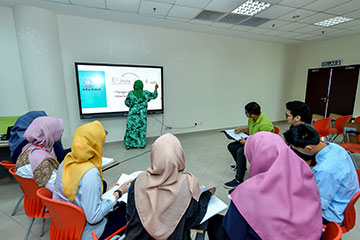
ISSN 1330-3651(Print), ISSN 1848-6339 (Online)
INTRODUCTION
Education is an organized process of transferring knowledge, skills, values and beliefs and is prerequisite for any improvement at individual or social level. Due to technological advance, new opportunities have emerged to fulfil the process of education. Amongst them, the strongest representative is the computer, which with its own abilities adds a completely new dimension to the education process. Education now aims to provide not only pure knowledge, but also continuous learning, critical thinking, questioning, as well as to keep up with innovations. Flexible training modalities and the use of self-learning methodologies as well as advanced technological support can provide adequate interactive learning. Technology in today’s society is rapidly evolving, influencing many aspects of our social and professional lives. It is known that Informal education facilities create active environments for students to interact with one another and engage them in discussion, while at the same time they are analysing aspects of the scientific method. Interactive whiteboard (further IWB) systems, another option to Interactive Smartboard Large TV Display, comprise a computer linked to a data projector and a large touch-sensitive board displaying the projected image; they allow direct input via finger or pen so that objects can be easily moved around the board (‘drag and drop’) or transformed by teacher or students. IWB offers a wide range of potential benefits for the presentation of the material in terms of the relative ease of integration of a large number of presentations and ICT, which, together, provide new opportunities for strengthening pedagogical strategies.
Interactivity between teachers, pupils and IWB provides the focus for the analysis of learning and teaching in the context of this non-standard learning environment. The positive effects of IWB are pointed in, as it allows easy and effective incorporation of a wide range of multimedia sources into lessons (text, images, video, sound, graphs, websites). The research shows that students are convinced that teaching with the IWB has positive effect on their learning, especially because of the visualization and contextualization, effectiveness of presentations and motivational factors. In another study, authors observed how IWB affects the students learning effectiveness and their perception towards learning environment. The results indicated that students from the IWB group learn more effectively and with more positive attitudes than traditional group. The papers indicated the advantage of using IWB for quickening the pace of lessons using pre-stored materials, which reduce the need for writing on the board.
Due to the ease of use, even those teachers who avoid the use of ICT can accept Interactive Whiteboard as a teaching tool. Authors think that it would be wrong not to use IWB in schools since the results of their study showed a positive effect of using IWB in classes. After this section of the paper, which represented an Introduction, and brief overview of related papers from the given field, emphasis will be given to the effects of the application of interactive whiteboards and educational software in the teaching process in primary schools.
Discussion
Based on the results it can be concluded that there is ability and interest of students to apply educational software and IWBs, because this way of learning improves quality of teaching making it visual and interactive. The research presented in this paper confirmed and verified the fact that success of today's educational process is widely influenced by the use of computers and interactive devices such as IWBs and educational software. The results obtained in this study show that educational software provides greater direct knowledge of users, as well as a higher level of cognitive, affective and sensor – motor skills, compared to traditional teaching – which proves the main hypothesis.
Although the software presented can be used in a relatively simple and familiar way, for cognition and acquiring knowledge, independent work with the IWB requires a certain computer literacy on the part of students. Therefore, the results of the research showed that the possession of computer literacy is important for work with educational software and interactive whiteboards – a finding that complies with the first subhypothesis. Interactive whiteboards with appropriate software usage give advantage to knowledge acquisition over classical education. Besides properly presented materials, great impact on work performance success, along with the use of educational software and IWB, has user motivation. The fact that experimental group students better remembered presented material suggests that they were more motivated to work, compared to students in control group, so it can be concluded that the use of educational IWB for education significantly increases the motivation of students’ learning, providing evidence for second sub-hypotheses.
Conclusion
The aim of this paper was to determine the facts about the ways of using IWBs and development of user interface as part of the educational software, as well as the motives and conditions that contribute to the fact that the use of educational technology software has a significant impact on the quality, efficiency and productivity of the educational process. The authors found that the results of research conducted in this paper, are comparable to similar experiences of international practice. Based on the results it was found that the most significant effects of the application of IWB and software are: – it allows easier and more effective incorporation of a wide range of multimedia sources into lessons; – in this way students learn more easily because of the more effective presentation of material and higher level of motivation; – teachers who initially avoid the use of ICT, accept more gladly IWB as a teaching tool – teachers can pass through the material more quickly because the use of pre-stored materials reduces the need for writing on the classic board.
One of the noticed differences in comparison with the practice in the world is a lower level of existence of IWB in schools, primarily due to reduced economic power. Another problem is the lack of both well-trained teachers and experts who create educational software, poor technical support for the use of such devices as well as shortage of educational software. It can be concluded that students show ability to learn through educational software and IWBs, and that ability may be influenced by the creation of adequate school habits at previous education levels. One of the essential conditions that learning process through IWBs could be effective is that students possess computer literacy, motivation and readiness for such a type of learning.
In addition to the student’s motivation, properly designed educational software has a significant role that will guide students through the process of acquiring knowledge, ensuring an accurate assessment of what has to be learned and providing the ability to understand presented educational material. Similar to [25], the research has shown that interactive whiteboards are able to keep students involved and foster their attention in every aspect of the curriculum, much easier than without it. Therefore, the authors are of the opinion that administration needs to invest in equipping schools with interactive whiteboards and necessary software. The invested funds would be returned through a higher level of knowledge, which is the primary objective of each level of education. Based on the experiences related to other ICT equipment, it can be expected that the prices of IWB will be declining in the future, which would make them more accessible. Because of that, there is no doubt that such or similar devices are going to be standard teaching means in almost every classroom in the near future. This paper speaks in favour of supporting and encouraging this trend.




